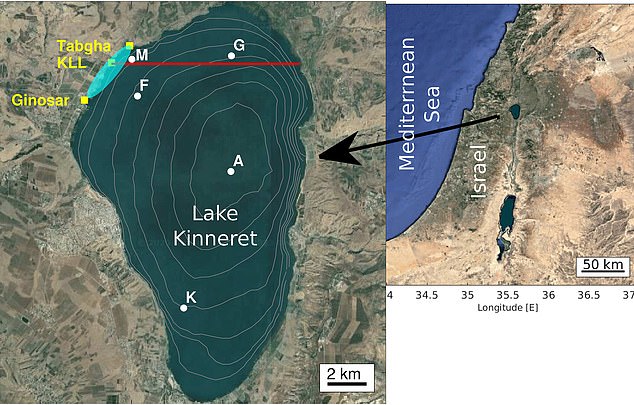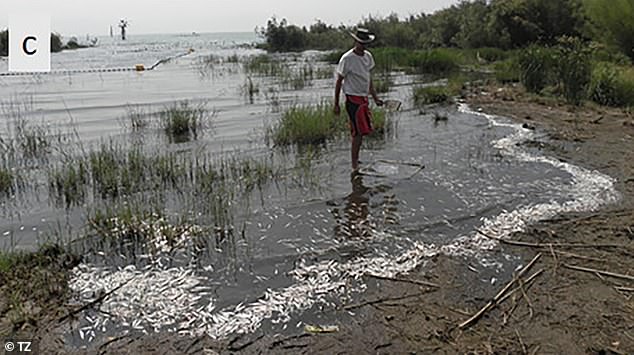Jesus’s fish miracle from Bible is explained by scientists for the first time
Scientists have discovered a possible explanation behind how Jesus performed one of his most famous miracles.
The Bible contains two stories in which Christ turned fishermen’s failed fishing attempts into huge catches that fed their communities for weeks.
Known as the ‘miraculous catch of fish’, the miracles are said to have been performed in Israel’s Lake Kinneret, where Jesus preached.
Now, a new study has found that a natural phenomenon that occurs at certain times of the year may have played a role.
Researchers from the Kinneret Limnological Laboratory in Israel have discovered that there are much lower oxygen levels deep in the water basin of Lake Kinneret.
This is due to an increase in phytoplankton blooms that block oxygen, causing fish to suffocate.
They identified two events in 2012 in which thousands of dead fish had floated to the surface along 3 miles (4.8 km) of the lake shore.
The researchers wrote: ‘[Our study] may explain the appearance of large numbers of easily collected fish close to shore described in the Biblical stories.’
The Biblical story of Jesus’ miraculous catch of fish could be a reality, researchers have discovered

Lake Kinneret is believed to be the same body of water mentioned in the New Testament, called the Sea of Galilee
Researchers say the theory supports the idea that Jesus and his miracles, which involved pulling more than a hundred fish from the sea, were real.
However, the revelations from the research have cast doubt on whether Jesus’ actions were truly miracles or whether they simply coincided with the natural elements of the lake.
The miraculous catch of fish occurred during two events and appears in the books of Luke and John – one in 27 AD before he was resurrected and one after his resurrection in 29 AD.
The miracles took place at Lake Kinneret, which is believed to be the Biblical Sea of Galilee mentioned in the New Testament.
In one account, Jesus instructed Simon Peter, a fisherman who had caught no fish that night, to cast his net into the water again.
Peter obeyed Jesus and caught so many fish that the nets almost broke, forcing them to ask another boat to help them bring the fish to shore.
In John 21:11, the Bible described the scene this way: “Simon Peter climbed aboard and dragged the net ashore. It was full of 153 large fish, but even with that many the net didn’t break.’
Jesus appeared again to his disciples after his resurrection in the book of John and repeated the miracle by instructing them to cast their net on the right side of the boat, resulting in another great catch.

Researchers tried to discover why hundreds of dead fish washed up on the shore of Lake Kinneret in 2012. They discovered that a lack of oxygen in the water had caused the fish to suffocate.
The researchers wanted to discover what could give fishermen easy access to thousands of fish.
They placed sensors in the lake to monitor the temperature in the water column and the direction and speed of the wind. The data suggested that the low oxygen levels in the water were caused by strong winds blowing in from the west.
Yael Amitai, a physical limnologist from the Kinneret laboratory, told the Times of Israel: ‘The Sea of Galilee is a layered lake. The top layer is warm and oxygen-rich, while the bottom layer is cold and contains no oxygen.’
Lake Kinneret is a warm-monotropic lake, meaning the surface temperature never drops below 39 degrees Fahrenheit and will separate into layers of water with varying temperatures due to the difference in the density of the water.
This process, called thermal stratification, occurs twice a year and mixes the upper layer of the Alert with the cooler lower layer of water to provide oxygen and nutrients to the entire lake.
Within the four to six weeks of thermal stratification, which takes place from March through April, Lake Kinneret becomes anoxic, meaning it becomes essentially devoid of all oxygen and unable to support most aquatic life.
According to the study, zooplanktivorous cyprinids – the most common fish species in the lake – were mainly found along the lake shore in 2012, but some larger dead fish were also discovered, including carp, catfish, tilapia and barbel.
This phenomenon is not unusual according to the researchers, who said it also occurred at Lake Erie and the mouth of the Neuse River in North Carolina.
However, this occurs sparingly, with the case at Lake Kinneret reported only twice in April 2007 and the early 20th century. The exact date was not noted.
The study found that these “fish kill events only occur in years with intense spring phytoplankton blooms.”
Phytoplankton is a microscopic algae that uses sunlight to make its own food, but when a species reproduces rapidly it can produce toxins that create oxygen-depleted dead zones that can kill the fish.
“Our study suggests a location and time frame for the biblical miracles near Tabgha documented in the Miracle of the Loaves and Fishes and the Miraculous Catch of Fish,” the researchers wrote in the paper published in the journal. Water resources research.
They suggested that lake conditions at the time were similar to what we see today and ‘2,000 years ago (when the Biblical miracles occurred) the Lake Kinneret basin was densely populated by approximately 200,000 farmers, which is comparable to the current population. in the region.’
